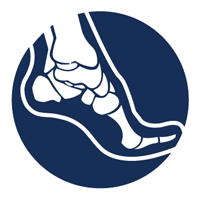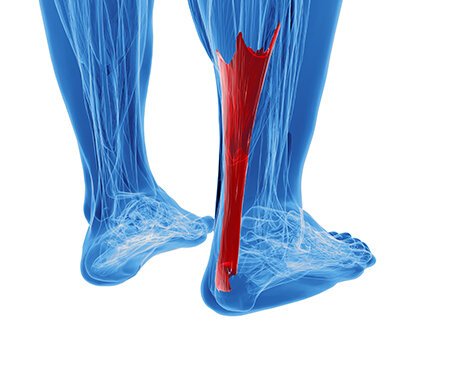What is an Achilles Tendon Rupture and how is it diagnosed?
The Achilles tendon is a large important tendon that connects the calf muscles to the heel bone (calcaneum). It enables you to push your foot down so you can walk or run and also allows you to stand on your tiptoes.
Achilles tendon rupture or tears can be either partial or complete and most likely occur in the calf area rather than the heel. In complete ruptures or tears of the Achilles tendon, the muscle connections are completely lost. As a result, you may get a very flat-footed type of walk where you can walk and weight bear but are unable to push your foot off the ground. You will also be unable to stand on your tiptoes in addition to pain and swelling of the calf or heel area.
An Achilles tendon tear can happen at any age but is more common in people between the ages of 30 to 50. It is more common in competitive athletes where training and sporting activities put a higher strain on the tendon.
An Achilles tendon tear is serious medical condition and you should seek medical care immediately and early diagnosis and treatment will help you heal and result in a better long-term condition.
What are the causes of an Achilles Tendon Rupture?
The most common cause of a tear to the Achilles tendon is a forceful push off the foot in sporting activities such as football, running, or basketball. A high force, high stress movement such as when a person is running or jumping may cause the tendon to tear. In most cases, the Achilles tendon is very strong and robust, and it takes excessive force and repeated injury to cause a tear.
Damage to the tendon can also be done through mechanical injuries such as falls from a high distance or deep cuts or lacerations to the calf muscles.
Long-term use of corticosteroids like prednisolone or diseases such as Cushing’s syndrome can weaken the Achilles tendon and make it more likely that a tear or rupture will occur.
The Achilles Tendon is a muscle that enables you to push your foot down.
What are some symptoms of an Achilles Tendon Rupture?
A sudden sharp pain in the calf during activities is the main symptom of an Achilles tendon tear and sometimes you will hear a snap sound. While the sharp pain will subside quickly, it will be followed by dull aching in the calf area. You may then find it difficult to walk and notice that your gait becomes very flat-footed since you are unable to lift your foot off the ground or stand on your tiptoes.
There may also be a physical gap just above the back of the heel although you may not be able to feel this because of bruising and swelling in the area.
How is an Achilles Tendon Rupture diagnosed?
A medical examination by a doctor and a history of your symptoms is usually enough to diagnose an Achilles tendon tear. A test called the Thompson’s test where the doctor will squeeze your calf and look for movements may be performed to confirm the diagnosis.
The Thompson’s test is a very useful test for Achilles tendon tears. The doctor will ask you to lie on your stomach and raise your foot from the knee. Your calf will then be squeezed and if the foot points away from the leg, the tendon is intact and working.
You may also be asked to undergo imaging such as an ultrasound or magnetic resonance imaging (MRI) to help confirm the diagnosis.
How can an Achilles Tendon Rupture be treated?
A suspected Achilles tendon tear is a serious medical condition and you should seek orthopaedic specialist attention or emergency attention urgently as early diagnosis and treatment greatly improves healing and your long-term condition. If you suspect you have an Achilles tendon tear, you should not weight bear on the foot and avoid walking on it.
Surgical repair of the tendon is the treatment of choice because it has the advantage of reducing the risk of the tendon rupturing or tearing again later. With surgery, the tendons are joined back together with small cuts to the area and then leg is placed in a plaster or casts to hold its position while healing.
The non-surgical option involves placing the leg in a plaster cast or brace and allowing the tendon to re-join naturally by keeping the ends close together. If this fails, the surgical option can be used afterwards. Unlike the surgical option, conservative treatments have the disadvantage of a higher risk of reoccurrence and a longer rehabilitation time. However, you will not be exposed to normal surgical risks such as wound infection or nerve injury.
What are surgical treatment options for an Achilles Tendon Rupture?
Achilles Tendon surgery is used to reattach and reconnect the important Achilles tendon in the calf. Without a functioning Achilles tendon, you may be unable to push your foot off the ground and notice your foot become very flat. You may also notice a gap above your heels.
If you suspect you have ruptured or torn your Achilles tendon, it is advised to seek expert consultation as soon as possible. Delay in treatment can cause the tendon is heal more slowly or reduce the effectiveness of the tendon after-repair due to stretching.
Read our article on Achilles Tendon Surgery.
Here’s what to do next…
Research your condition and treatment options
We provide extensive information about Achilles Tendon Rupture Surgery on our procedures page.
Do further research and contact us with any questions you may have.
Book a consultation with Associate Professor Roderick Kuo
Prior to your appointment, please obtain a referral from your General Practitioner. This will allow you to claim a Medicare rebate on the consultation fees.
Call or email our team at Specialty Orthopaedics to book your consultation.
Important: Information is provided for guidance only. Individual circumstances may differ and the best way to approach a condition is by individual medical consultation where a specialist can tailor a treatment plan to suit your needs.
Edited by Dr Roderick Kuo
Last updated: 5/5/24



